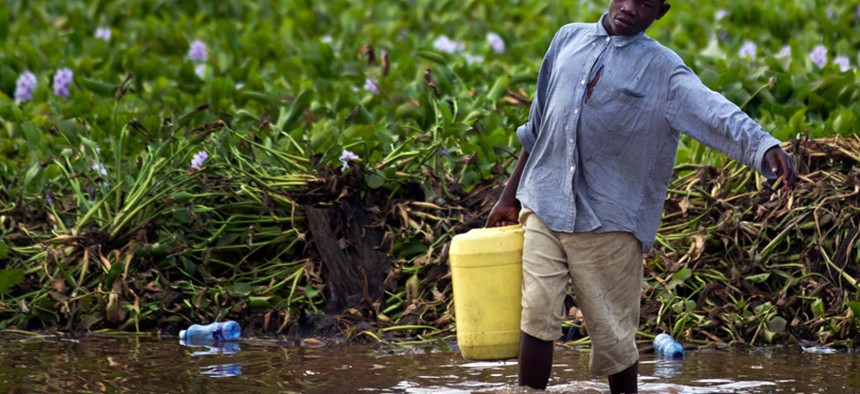Innovative Funding Begets Innovative Development

A man gathers water from Lake Victoria in Kisumu, Kenya. Ben Curtis/AP
A USAID-funded project to chlorinate drinking water near its source will affect 5 million people by 2015.
Chlorinating water, a bug-killing intervention that the industrialized world largely takes for granted, can be prohibitively difficult in the developing world.
There’s rarely a municipal authority that will add chlorine before piping water to your home. Adding it yourself cup by cup can be extremely onerous and it’s easy to forget. The result is children in developing nations have higher rates of sometimes fatal diseases such as childhood diarrhea. When these diseases aren’t fatal, they still increase school absenteeism, ultimately lowering children’s lifetime earnings.
The nonprofit Innovations for Poverty Actions had a simple innovation they thought might fix this problem: a durable chlorine dispenser placed near rivers, wells and other sources so people could chlorinate water just once when they gathered it. The dispensers are coupled with an education program about the benefits of chlorination.
After proving itself in the field, Innovations for Poverty Action received a grant from the United States Agency for International Development’s Development Innovation Ventures program to scale in Kenya.
DIV is patterned after the Silicon Valley model of angel investing for early-stage but promising initiatives and larger amounts of staged funding for projects that are more proven but not yet self-sustaining. The handful of projects that have earned stage 3 funding, including IPA’s chlorine dispensers, can receive up to $15 million. Most DIV projects receive stage 1 funding, which tops out at $100,000.
IPA expects to be providing chlorination to 5 million people by 2015 and to 23 million people within several years, said Alix Zwane, executive director of an IPA spin off Evidence Action, who worked on the project.
“We were able to apply for a stage 3 grant from DIV because a great deal of investment had been made in rigorous randomized control trials to identify how this change in technology would interplay in interesting ways with people’s behavior,” Zwane said. “We could say really credibly to USAID ‘this is really good value for the money for you. We have good data to support that claim.’”
This month, USAID announced a partnership with Britain’s Department for International Development and the Omidyar Network, which invests in economic development projects, on an international version of the DIV initiative. The Omidyar Network was created by eBay founder Pierre Omidyar.
Zwane described the project on a White House webcast Thursday along with other DIV grant recipients. The webcast was part of the White House’s We the Geeks series using the Google+ hangout feature, which highlights technology innovations throughout government.
The full webcast is available here.
NEXT STORY: How We Name the Things We Find on Mars



